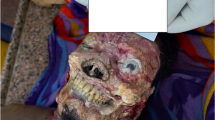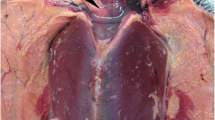Abstract
A 67-year-old woman with a history of previous cerebrovascular accidents who was confined to a wheel chair drowned in a pond in a public park. Features compatible with drowning included congestion and edema of the lungs with prominent hemolytic staining of the intima of the aortic root. Minor bruises and abrasions were identified. Toxicology was negative. An additional unusual finding was that of patterned symmetrical injuries to the earlobe and pinna of both ears. The injuries consisted of small irregular areas of skin loss that were sometimes linear and parallel and had the appearance of animal nibble marks. Given the presence in the pond of numerous Australian fresh water yabbies (Cherax destructor), and no other predators, it appeared that the injuries had been caused by post mortem feeding by these crustaceans. This case therefore extends the range of animals that may be involved in post mortem predation that may be encountered in cases of freshwater drowning/immersion in an Australian context, with a specific pattern of injury focused on the ear lobes.
Similar content being viewed by others
Avoid common mistakes on your manuscript.
Case report
A 67-year-old woman who was confined to a wheel chair due to previous cerebrovascular accidents was found in a pond in a public park. She was retrieved by ambulance personnel. At autopsy the body was that of an obese adult white female (length – 174 cm; weight – 117 Kilograms; BMI - 38.6). Rigor mortis was generalized involving the legs, arms, and jaw. Evidence of drowning consisted of congestion and edema of the lungs with prominent hemolytic staining of the intima of the aortic root (Fig. 1).
a Cross sections of the aortic root and pulmonary trunk showing characteristic differential intimal staining typical of freshwater drowning (“hemimbibition”). The aortic root is bright red from erythrocyte hemolysis compared to the pulmonary trunk which has the more usual yellow white color. b Sections of the aortic root (red) compared to the pulmonary trunk (white) to further demonstrate differential aortopulmonary staining
Marked distal left anterior descending coronary artery atherosclerosis (80%) was noted with no evidence of acute or chronic ischemic myocardial damage. Previous hemorrhagic infarction of the posterior left temporal lobe was present in the territory of the left middle cerebral artery. There were also old small bilateral hemorrhagic infarcts in the periventricular region around the third ventricle with hydrocephalus ex vacuo involving the lateral and third ventricles. Incidental findings included a benign endometrial polyp, cholesterolosis of the gallbladder, a benign cyst of the left ovary, mild nephrosclerosis and moderate dorsal osteoarthritis with osteophyte formation.
Minor injuries were present that included bruising and abrasions of the lips, bruising of the back of the right hand, red bruising in the left trapezius muscle at the base of the neck, an interrupted area of red bruising in muscles on the posterior aspect of the left arm, red bruising in muscles over the posterior aspect of the left shoulder, red bruising in adipose tissue in the mid-portion of the left lower back and an area of red bruising on the medial posterior aspect of the right elbow. None of the injuries were medically significant and the pattern was not that of an assault. There was no pathological evidence of compression of the neck or the body, with no facial or conjunctival petechiae. There was no evidence of hypothermia and the water temperature the following day at 1500 was 18.5 °C. No alcohol or common drugs were detected on comprehensive toxicology screening.
An additional unusual finding, however, was that of patterned injuries to the earlobe and pinna of both ears. The injuries consisted of small, quite discrete but irregular areas of skin loss that were sometimes linear and parallel with the appearance of animal nibble marks (Fig. 2a-c). There were also several similar lesions on the tip of the nose. Given the presence in the pond of numerous Australian fresh water yabbies (Cherax destructor) (Fig. 3), and no other predators, it appeared that the injuries had been caused by post mortem feeding by these crustaceans.
a The right ear of the decedent showing unusual injuries to the earlobe and pinna. The injuries consist of small, quite discrete but irregular areas of skin loss that are sometimes linear and parallel in keeping with post mortem predation from Australian fresh water crayfish, Cherax destructor.b The left ear of the decedent showing similar lesions. c. A close up view of the right earlobe showing the nibbled pattern of injuries with no evidence of bleeding
Death was therefore attributed to drowning in fresh/brackish water given the alleged circumstances and the findings at autopsy of congestion and edema of the lungs and hemolytic staining of the lining of the aortic root. It was also possible that significant atherosclerosis of one of the three major epicardial coronary arteries may have contributed to the lethal episode. The manner of death was undetermined.
Discussion
On occasion the evaluation of cases at autopsy is complicated by tissue damage caused by post mortem animal predation. Animals may modify or destroy existing injuries or may create entirely new lesions which can either simulate ante mortem injuries or obscure significant underlying natural diseases [1, 2]. The type of tissue damage is often very species dependent. For example, ants will shave off superficial layers of skin creating serpiginous parchmented lesions which may resemble ante mortem abrasions. This may, however, be useful if the shaved areas of skin provide outlines of clothing, or give an indication of the position that the body has been lying in for some time [3, 4]. Fly larvae (maggots) are more invasive and may consume large portions of bodies complicating evaluation of underlying traumatic or pathological lesions.
The nature of such post mortem changes is also very dependent on the particular environment in which the body is found, as aquatic animals may cause quite different lesions to terrestrial species. The likelihood of post mortem damage may also be related to psychosocial features of a case, with elderly recluses having a higher rate of predation from rodents or pet cats or dogs than individuals with a more active network of social contacts [5].
Larger predators such as dogs characteristically remove the soft tissues of the face and will open both the cranial and chest cavities in their pursuit of nutrition. The type of injury also depends on the age and size of the decedent with, for example, dogs tending to remove limbs from smaller neonates [6]. On the other hand, rodents will focus on the tips of the fingers and toes, and the nose, producing typical parallel nibble marks. Targeting of the anogenital region may raise suspicions of a sexually motivated sadistic attack [7].
An important part of autopsy evaluations is, therefore, the description and documentation of post mortem injuries caused by animal activity. This also includes the identification of injury patterns from species that may not have been recognized as human tissue scavengers previously. In the current report the body of an elderly female had been recovered from a pond in a public park. Death was due to freshwater drowning with only minor bruises and abrasions that were most likely caused by impact with the rocky edges of the pond during terminal struggling. The presence of significant underlying stenosing coronary artery atherosclerosis may also have been a contributory factor.
An unusual feature in the reported case however was the presence of small clustered bilateral symmetrical skin defects around the edges of the ears. Although these superficially resembled abrasions/lacerations from possible contact with a rough surface, closer examination revealed a “nibbled” pattern somewhat similar in morphology to those caused by rodent feeding activity. When the pond was drained as part of the police investigation, numerous small freshwater crayfish, Cherax destructor, were identified. No other animal or fish species were present.
The Australian fresh water crayfish or yabby is a native crustacean that is found in a wide variety of aquatic environments which include rivers, reservoirs, dams, streams and swamps [8]. It is also capable of surviving in dry or drought conditions by burrowing deep into the mud of waterways. Yabbies normally live in complex underwater burrows in water that is often dark and turbid, as in the present case. These features are likely defense mechanisms against predators [9]. The taxonomic classification has been difficult because of considerable phenotypic variability, however it is generally accepted that Cherax destructor consists of a single species composed of two subspecies [8].
Yabbies usually feed at night and are omnivorous detritivores consuming algae and plant remains in addition to chironomid larvae, nymphs and snails [10]. Although it has been suggested that younger yabbies require more animal matter in their diets than older crustaceans [11], the crushing effect of the gastric mill (part of the stomach in crustaceans containing teeth) in Cherax destructor at any age facilitates the digestion of animal material which may then be difficult to identify [12]. Opportunistic feeding on animal or fish remains that yabbies may discover in their aquatic environment, which is well recognized behavior, would explain the injuries observed in the current case.
In summary, this case demonstrates an unusual pattern of skin damage focused on the ear lobes that is attributed to the activities of the Australian fresh water crayfish, Cherax destructor. This is the first time that such injuries have been described in a forensic context and extends the range of animals that may be involved in post mortem predation and that may be encountered in cases of freshwater drowning/immersion in an Australian environment. Unusual abraded injuries to the ears in freshwater drowning victims should raise the possibility of post mortem crustacean activity rather than ante mortem injury.
References
Byard RW. Animals, autopsies and artefacts. Forensic Sci Med Pathol. 2011;7:309–10.
Byard RW, James RA, Gilbert JD. Diagnostic problems associated with cadaveric trauma from animal activity. Am J Forensic Med Pathol. 2002;23:238–44.
Heath KJ, Byard RW. Ant activity as a source of post mortem bleeding. Forensic Sci Med Pathol. 2014;10:472–4.
Byard RW, Heath KJ. Patterned postmortem ant abrasions outlining clothing and body position after death. J Forensic Legal Med. 2014;26:10–3.
Byard RW, Tsokos M. Forensic issues in cases of Diogenes syndrome. Am J Forensic Med Pathol. 2007;28:177–81.
Omond KJ, Winskog C, Calla A, Byard RW. Neonatal limb amputation – an unusual type of postmortem canine predation. J Forensic Sci. 2017;62:937–9.
Byard RW. Implications of genital mutilation at autopsy. J Forensic Sci. 2017;62:926–9.
Nguyen TTT, Austin CM, Meewan MM, Schultz MB, Jerry DR. Phylogeography of the freshwater crayfish Cherax destructor Clark (Parastacidae) in inland Australia: historical fragmentation and recent range expansion. Biol J Linn Soc. 2004;83:539–50.
Basil J, Sandeman D. Crayfish (Cherax destructor) use tactile cues to detect and learn topographical changes in their environment. Ethology. 2000;106:247–59.
Meakin CA, Qin JG, Mair GC. Feeding behaviour, efficiency and food preference in yabbies Cherax destructor. Hydrobiologia. 2008;605:29–35.
Verhoef GD, Jones PL, Austin CM. A comparison of natural and artificial diets for juveniles of the Australian freshwater crayfish Cherax destructor. J World Aquacult Soc. 1998;29:243–8.
Maxwell Linton S, Allardyce BJ, Hagen W, Wenke P, Saborowski R. Food utilization and digestive ability of aquatic and semi-terrestrial crayfishes, Cherax destructor and Engaeus sericatus (Astacidae, Parastacidae). J Comp Physiol B. 2009;179:493–507.
Author information
Authors and Affiliations
Corresponding author
Additional information
Publisher’s note
Springer Nature remains neutral with regard to jurisdictional claims in published maps and institutional affiliations.
Rights and permissions
About this article
Cite this article
Byard, R.W. An unusual pattern of post-mortem injury caused by Australian fresh water yabbies (Cherax destructor). Forensic Sci Med Pathol 16, 373–376 (2020). https://doi.org/10.1007/s12024-019-00203-5
Accepted:
Published:
Issue Date:
DOI: https://doi.org/10.1007/s12024-019-00203-5







